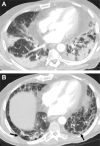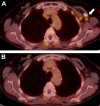Review of Thoracic Imaging Manifestations of COVID-19 and Other Pathologic Coronaviruses
- PMID: 35534124
- PMCID: PMC8747969
- DOI: 10.1016/j.rcl.2022.01.004
Review of Thoracic Imaging Manifestations of COVID-19 and Other Pathologic Coronaviruses
Abstract
Severe acute respiratory syndrome coronavirus 2 (SARS-CoV-2) is an easily transmissible coronavirus that emerged in late 2019 and has caused a global pandemic characterized by acute respiratory disease named coronavirus disease 2019 (COVID-19). Diagnostic imaging can be helpful as a complementary tool in supporting the diagnosis of COVID-19 and identifying alternative pathology. This article presents an overview of acute and postacute imaging findings in COVID-19.
Keywords: Computed tomography; Coronavirus disease 2019 (COVID-19); Middle East respiratory syndrome coronavirus (MERS-CoV); Severe acute respiratory syndrome coronavirus (SARS-CoV); Severe acute respiratory syndrome coronavirus 2 (SARS-CoV-2).
Published by Elsevier Inc.
Figures


















References
-
- Stawicki S.P., Jeanmonod R., Miller A.C., et al. The 2019-2020 Novel Coronavirus (Severe Acute Respiratory Syndrome Coronavirus 2) Pandemic: A Joint American College of Academic International Medicine-World Academic Council of Emergency Medicine Multidisciplinary COVID-19 Working Group Consensus Paper. J Glob Infect Dis. 2020;12(2):47–93. - PMC - PubMed
-
- Johns Hopkins Coronavirus Resource Center. https://coronavirus.jhu.edu/map.html Available at: Accessed October 6, 2021.
-
- Centers for Disease Control CDC Coronavirus Disease 2019 (COVID 2019) Basics. 2020. www.cdc.gov Available at: Accessed September 10, 2021.
Publication types
MeSH terms
LinkOut - more resources
Full Text Sources
Medical
Miscellaneous

